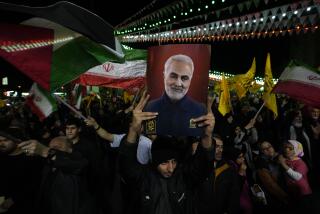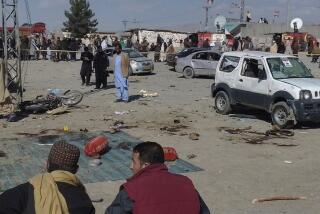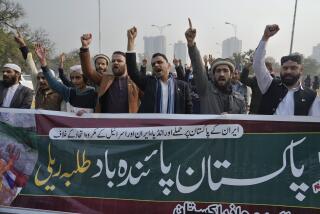Afghan suicide bombing raises regional tensions
KABUL, AFGHANISTAN — The massive car bomb that killed more than 40 people outside the Indian Embassy here Monday has stoked regional tensions and threatened to erode already diminishing confidence in the government of Afghan President Hamid Karzai.
Afghanistan’s Interior Ministry indirectly blamed Pakistan for the suicide attack, the deadliest in Kabul since the fall of the Taliban movement in 2001. Nearly 150 people were injured in the bombing, an audacious strike in what had previously been considered a well-secured area of the capital.
Pakistan swiftly condemned the attack, which nonetheless was expected to generate more acrimony between the two neighbors, both considered key U.S. allies in the fight against Islamic militants. Afghan officials accused Pakistan’s main intelligence service of having had a hand in an assassination attempt against Karzai in April. Last month, the Afghan leader threatened to send troops into Pakistan if authorities there could not stem the cross-border movement of insurgents into Afghanistan.
Long-standing tensions between India and Pakistan have at various times become entangled in the Afghan conflict. However, it was not immediately clear who carried out the bombing or why the Indian Embassy was targeted.
The bombing came amid surging violence in Afghanistan and as the writ of the Karzai government has been weakening across the country. Many ordinary Afghans are bitterly disillusioned that daily life remains filled with hardship and fraught with danger six years after the U.S.-led invasion.
The bombing drew condemnation from the NATO-led International Security Assistance Force, which is battling to subdue Taliban fighters in the country’s south and increasingly violent east. New data released last month by the U.S. military showed attacks in the east were up 40%. In the south, the Taliban’s traditional homeland, the military deployed more than 2,000 additional Marines in March to help allied forces.
Fatalities among Western troops are running at their highest levels since the start of the war, with 127 killed so far this year, according to the website icasualties.org -- on pace to surpass last year’s toll of 232.
But attacks like Monday’s, even if aimed at official installations, tend to hit the most vulnerable.
Witnesses said the bomber tried to ram a pair of diplomatic vehicles entering the Indian Embassy complex just after 8:30 a.m. But passersby on the busy thoroughfare in central Kabul, including women, infants and children, took the brunt of the powerful explosion, which reverberated across the city.
Injured people writhed in the debris-choked street, shrieking in pain, and a cloud of gray dust filled the air.
Ambulances rushed to the scene, but some were caught in the capital’s chaotic traffic jams and idled with sirens wailing.
The force of the explosion blew out the embassy’s front gates, knocked down its perimeter wall and damaged buildings in the compound. Nearly a dozen of the dead were thought to be Afghan men who had been waiting in line just outside, hoping to obtain Indian visas.
At nearby hospitals, there were wrenching scenes as people searched for loved ones. Jalauddin, 20, who, like many Afghans, uses only one name, was bleeding from cuts as he begged doctors for information about his brother. They were both in the area of the embassy when the bomber struck.
“Now I cannot find him,” he said, weeping.
Although suspicion fell on the Taliban, there was no immediate claim of responsibility, and news agencies cited a Taliban spokesman as denying any role. However, the insurgents often disclaim knowledge of attacks that kill and maim large numbers of civilians.
In the veiled accusation against Pakistan, the Afghan Interior Ministry said the attack had been carried out “in coordination and consultation with some of the active intelligence services in the region.”
Karzai suggested that “enemies of peace” wanted to harm ties between India and Afghanistan. But he did not specifically blame any outside party.
Pakistan’s support in the 1990s of the Taliban movement was part of a push by its shadowy intelligence agencies to create a counterweight to Indian influence in the region. India in turn lent its support to opposition fighters who eventually coalesced into the American-allied Northern Alliance.
India has since invested millions of dollars in the effort to rebuild this ravaged country, including money for a new parliament building in Kabul. Its nationals have been targets of violence in Afghanistan, including a number of contractors and workers who have been kidnapped and killed.
At least four Indian nationals were among the dead in Monday’s blast, including the embassy’s defense attache, Afghan and Indian officials said.
The attack sent shock waves across India. Prime Minister Manmohan Singh, in Japan to attend the G-8 summit of industrialized nations as a guest, condemned the bombing as a “dastardly terrorist attack” carried out by “the worst criminals.”
“We have lost Indians who were helping their Afghan brothers to rebuild their lives and country,” Singh said in a statement. “That endeavor must continue with renewed commitment.”
Across the border, Pakistan’s nearly 4-month-old coalition government has been struggling to contain a spiraling insurgency of its own. On Monday, the death toll in a suicide blast a day earlier near a radical mosque in Islamabad rose to at least 18 with the deaths of three more police officers, authorities said. That attack came hours after thousands from all over Pakistan converged on the Red Mosque to protest a siege by the government last year that left more than 100 people dead.
In Pakistan’s largest city, Karachi, about three dozen people were hurt in a series of small bomb blasts in widely scattered neighborhoods. There was no immediate claim of responsibility, and the motive for the explosions was not known.
--
Special correspondent Faiez reported from Kabul and Times staff writer King from Dubai, United Arab Emirates. New Delhi Bureau Chief Henry Chu contributed to this report.
More to Read
Sign up for Essential California
The most important California stories and recommendations in your inbox every morning.
You may occasionally receive promotional content from the Los Angeles Times.










